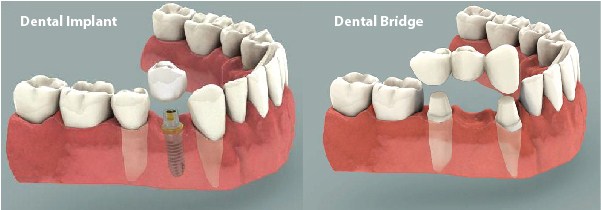If you’re missing a tooth — whether it’s from an accident, decay, or gum disease — you’re probably weighing your options. And the two most common solutions your dentist might suggest are dental implantsand dental bridges. But how do you choose between them? The truth is, both can restore your smile, but they work in very different ways.
Let me break it down like I would for a patient sitting across from me in the clinic. A dental implant is a titanium post that acts like a synthetic tooth root. It’s placed into your jawbone, and over time, your bone actually fuses with it. Then, a crown is placed on top, and voilà — it looks and functions just like your natural tooth. It’s kind of like planting a tree: you place the root first, let it grow strong, and then add the beautiful top.
A dental bridge, on the other hand, is more like building a small suspension bridge across a gap in your teeth. It uses the healthy teeth on either side of the missing one as anchors. Those anchoring teeth are shaved down a bit, and a prosthetic tooth is fixed between them. It “bridges” the space, hence the name.
Now, when I explain this to my patients, I always emphasize: it’s not about which option is better on paper. It’s about which one fits your lifestyle, your oral health, and your long-term goals. Think of it like choosing between a permanent renovation (implants) and a solid, efficient fix (bridges). Both have their place, but your choice should be based on more than just cost or speed.
Every smile tells a story — and your replacement should feel like the next natural chapter. When patients come to me unsure whether to go for a bridge or implant, we start with one simple question: What’s most important to you?Longevity? Cost? Speed? Natural appearance? Every answer leads us in a slightly different direction.
For example, someone in their 30s who lost a tooth in a bike accident might want a dental implant because it’s a long-term solution and doesn’t impact the surrounding healthy teeth. Since implants integrate with the bone, they prevent future bone loss and help keep the structure of the face intact — a detail younger patients often care about. Plus, the implant feels like a natural tooth. You can eat apples, chew steak, and forget it’s even there.
On the flip side, an older patient with weaker jawbone structure — or someone who doesn’t want to undergo minor surgery — might find a dental bridgemore appealing. It’s faster, often more affordable upfront, and still delivers a great aesthetic result. But it does require modifying the neighboring teeth, and over time, those anchor teeth can wear down.
Emotionally, I’ve had patients express fears around surgery, cost, and just the idea of having something artificial in their mouth. And that’s completely normal. My role is to walk you through the process, listen to what matters most, and help you weigh the pros and cons of dental implants vs bridges in a way that feels empowering — not overwhelming.
Let’s talk comfort — because let’s face it, nobody wants a solution that feels weird in their mouth. I like to compare this to wearing a good pair of shoes. A great fit makes you forget you’re even wearing them. A bad fit? You’re thinking about it all day.
In general, dental implants win in the comfort department. Once healed, they feel just like your real teeth because they’re anchored into your bone. You don’t have to worry about them shifting or slipping. You clean them like your natural teeth — brush, floss, done. That seamless experience is a huge relief for many patients.
Dental bridges, while also stable, can sometimes feel different at first. Since they rely on neighboring teeth for support, they don’t have the same deep-rooted feel that an implant offers. Some patients describe a slight awareness of the bridge when chewing hard foods, especially early on. Also, cleaning around a bridge takes a little more effort — you’ll need to use floss threaders or special brushes to keep the area underneath clean.
But it’s worth noting that some patients adjust perfectly to bridges and are thrilled with their results. One of my long-time patients once said, “I don’t even remember which tooth was replaced anymore.” So again, it comes down to your personal preferences, anatomy, and oral hygiene habits.
Dental implants typically last much longer — often 20 years or more with good care. In fact, many implants last a lifetime. That’s one of their biggest selling points. The crown (the visible tooth part) might need replacement after 10–15 years due to wear, but the implant itself can remain rock solid.
Dental bridges, on the other hand, usually last about 10–15 years. And their lifespan heavily depends on how well you care for the supporting teeth. If those teeth develop decay or gum issues, the bridge can become compromised.
So if you’re looking for a long-term investment in your smile, and you’re okay with a slightly longer healing process upfront, implants are usually the more durable choice.
That’s a common and important question. Dental bridges are usually more affordable upfront. They involve fewer appointments, no surgery, and don’t require bone grafting or specialized imaging. For someone looking for a quicker and more cost-effective solution, they make a lot of sense.
Dental implants, while more expensive initially, may save you money in the long run. Why? Because they don’t need to be replaced as often, they help preserve bone (which can reduce future dental costs), and they don’t rely on neighboring teeth, which helps keep those teeth healthier over time.
Here’s how I explain it to patients: getting a bridge is like buying a reliable car that’ll last a good 10 years. Getting an implant is like investing in a higher-end model that could easily last twice as long with fewer repairs. It’s all about what you’re comfortable with — both financially and emotionally.
Choosing between dental implants and dental bridges isn’t about picking the “best” option — it’s about picking the right one for you. Every mouth is different. Every patient’s lifestyle, health, and goals are unique. The good news? Both options can give you back a confident, functional smile. The key is having an honest conversation with a dentist who listens, explains, and cares about your long-term health.
If you’re still unsure, that’s okay. That’s what consultations are for. Sit down with your dentist, share your concerns, ask questions, and explore your options in detail. We’re here to guide you, not rush you. Replacing a missing tooth is more than a procedure — it’s a big step toward smiling, eating, and living with confidence again.

